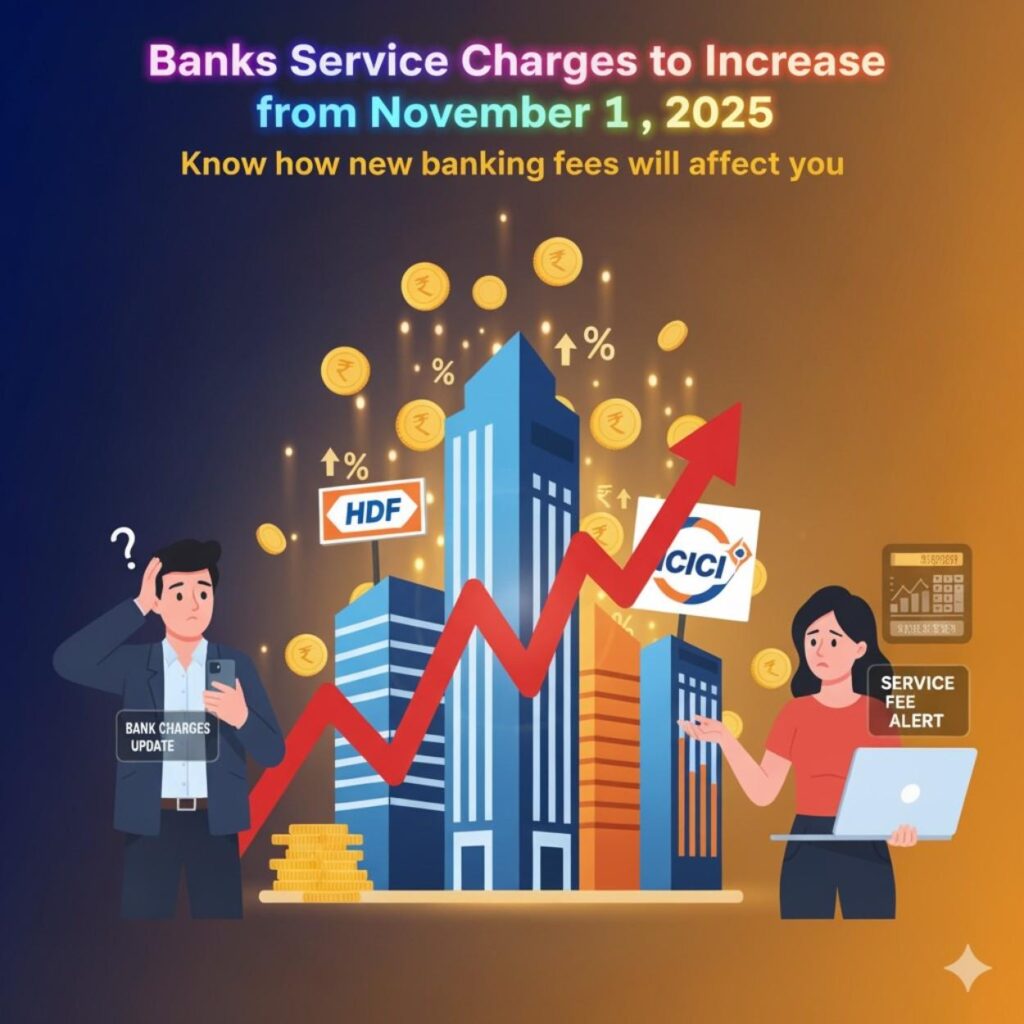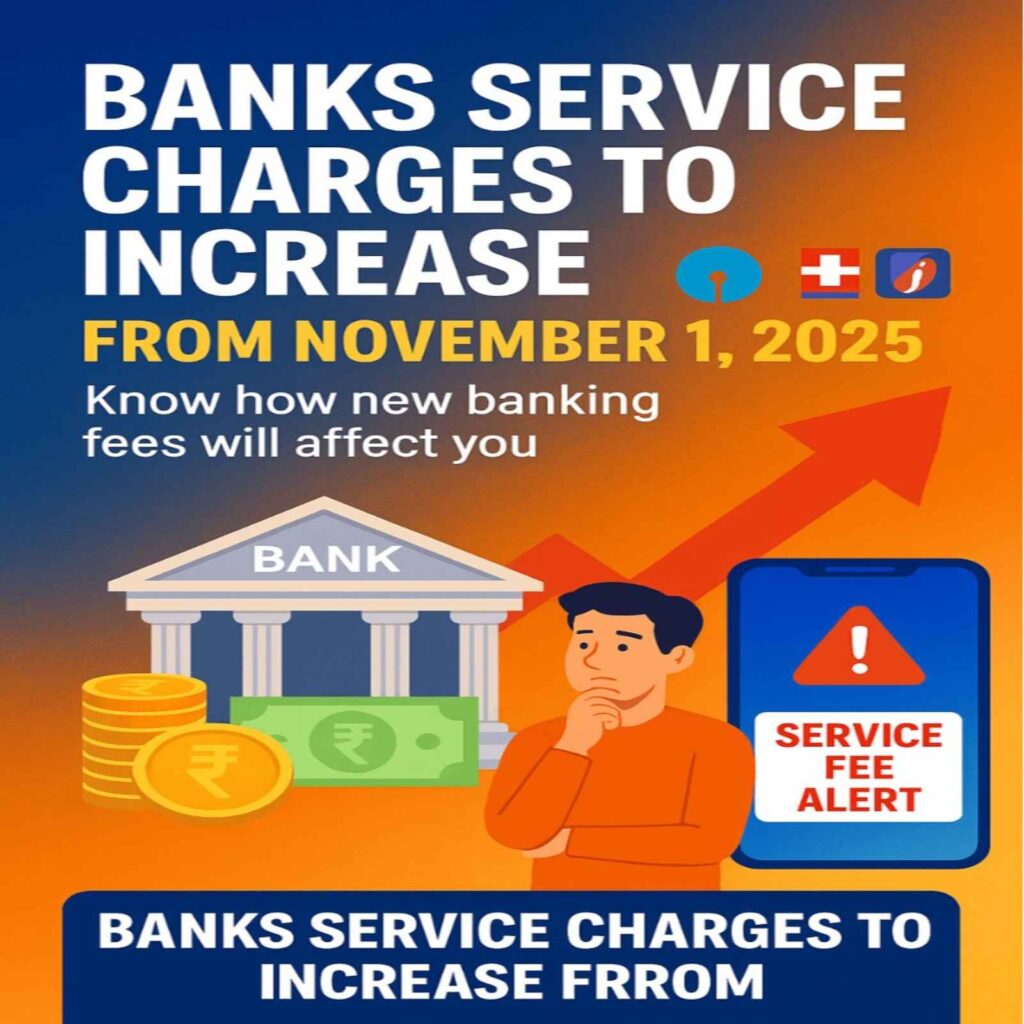
Table of Contents
Introduction : Banks Service Charges
Starting November 1, 2025, many public and private banks across India are set to implement revisions in banks service charges, especially affecting online services and certain branch-based offerings. These hikes will impact millions of customers, particularly those who rely heavily on digital banking or frequent branch services. Below is a full breakdown: what’s changing, which banks are involved, how much extra you may pay, and what customers can do to soften the impact.
Why Are Banks Service Charges Increasing ?
Over the past decade, banks have gradually introduced or increased fees on more and more services. The latest round is being justified by banks as a response to rising operational costs, inflation, and the need to balance non-interest income streams.
According to a government reply in Parliament, state-owned banks have earned over ₹2,300 crore in service charges from their online services in the last five years. Under the Reserve Bank of India’s norms, boards of individual banks have the authority to fix “reasonable” service charges, as long as they display them publicly.
At the same time, the RBI has expressed concern about the burden these fees place on lower-income customers and has recently nudged banks to reduce some retail charges — such as those for debit cards, minimum balance penalties, and late payments. This tension makes the coming November hike particularly sensitive.

What New Banks Service Charges Will Apply from November 1, 2025
| Service / Activity | New or Revised Banks Service Charges | Notes / Conditions |
|---|---|---|
| Duplicate passbook (basic) | ₹100 | If customer requests a fresh copy |
| Duplicate passbook with entries | ₹1 per page | Additional pages will incur per-page fees |
| Stop payment of cheque | ₹200 per cheque | For specific cheque issuance you ask to stop |
| Cheque bounce due to customer fault | ₹150 | If cheque is returned because of your error |
| Signature verification | ₹100 | When bank needs to verify your signature |
| Joint account signature check | ₹150 | For verifying signatures in joint account |
| Demand draft (₹5,000 to ₹10,000) | ₹75 | For issuance of demand drafts in that value band |
| Withdrawals beyond 5 free in a month | ₹75 each | After crossing a threshold of free transactions |
| Account maintenance / “account upkeep” fee | ₹500 annually | For maintaining the account |
| SMS alert (per quarter) | ₹10 to ₹35 | Depending on number of alerts or bank plan |
| Change of mobile number / email ID | ₹50 + GST | For updating contact details in bank records |
| Debit card issuance / maintenance | ₹250 to ₹800 | Varies by card type and bank |
| Debit card PIN / re-issue | ₹25 to ₹50 | For replacement or re-pin requests |
| Night deposits in Cash Recycler Machines (CRM) | ₹50 per transaction | For deposits made between 11 pm and 7 am (HDFC Bank example) |
Which Banks Service Charges Are Already Raising / Changing Charges?
Even before November, several major banks have begun revising service charges, especially from October 1, 2025:
- Punjab National Bank (PNB): From October 1, PNB has raised locker rents across many branches (based on location & size), revised the charge for failed standing instructions (SI) by switching to a flat monthly fee instead of per transaction, and adjusted nomination/one-time registration fees.
- HDFC Bank: It has already announced increased costs for cash / cheque transactions, NEFT / IMPS / RTGS / ECS return charges, and issuance of service certificates.
- ICICI Bank: Effective July 1, 2025, ICICI revised charges related to ATMs, demand drafts, cash deposits, withdrawals, and debit card services.
These earlier hikes suggest a broader trend: banks are systematically revising multiple fee categories over 2025. The November 1 changes will only deepen this shift.
Banks Service Charges Impact on Customers — Who Pays More?
- Frequent digital users: People doing many online transactions (fund transfers, bill payments, wallet top-ups, etc.) will see noticeable additions in their monthly banking cost due to increasing Banks Service Charges.
- High-value utility payments: Those who make large payments (electricity, gas, phone, school fees) via third-party apps may incur new percentage-based charges.
- Branch service users: Customers relying on physical branch services — e.g. passbook requests, cheque handling, signature authentications — will feel the pinch.
- Low-balance / occasional users: The account maintenance fee (₹500 in example) may especially hurt users who maintain small balances.
- Night-time depositors: If your bank adopts night deposit fees (as in the HDFC example), those depositing cash outside regular hours will pay for that convenience.
Banks will typically display or publish their revised service charge schedules, and you should receive notice via the bank’s website, branches, or communications.
How Does Banks Service Charges Align with RBI’s Position?
While banks are pushing ahead with higher service charges, the Reserve Bank of India (RBI) is simultaneously pushing in the opposite direction for certain retail fees. The RBI has requested banks to scale down charges on essential services such as debit cards, late payments, and minimum balance violations — especially those that disproportionately affect low-income or small account holders.
This conflict reflects a delicate balance: banks are under pressure to maintain profitability amid rising costs, while the regulator must protect consumer interests. How this dynamic plays out may determine whether further hikes are implemented or curbed.
What Should Customers Do when Banks Service Charges increases?
Here are some steps you can take to mitigate the impact of higher banks service charges:
- Check your bank’s revised schedule
Once your bank publishes its new service-charge list, compare it to your current usage pattern and see which new fees affect you. - Minimize branch service usage
Use digital banking wherever possible — fewer in-person requests (like duplicate passbooks, signature verification, etc.) means fewer extra charges. - Optimize transaction timing
Avoid transactions during “night hours” if your bank introduces extra fees for after-hours deposits. - Consolidate payments / transfers
Instead of multiple small transfers, try bundling payments to reduce repeat fee triggers. - Maintain required balances
If your account type requires an average balance, ensure you meet or exceed it to avoid penalty fees. - Choose the right account type
Some banks offer “basic” or low-fee accounts. If your usage is light, switching to a lower-fee plan might save you over time. - Provide feedback / appeal
Banks often accept customer feedback. If a fee seems unfair, ask for explanations or concessions.
Challenges and Criticism on Banks Service Charges
- Affordability for small users: Many critics argue that service charge hikes hurt those with low incomes or small accounts more than affluent users.
- Transparency concerns: Banks must clearly display their fee changes; sudden or hidden fees could invite regulatory scrutiny.
- Regulatory pushback: If customers complain enough and the RBI intervenes more aggressively, banks may face pressure to rollback some increases.
Conclusion
From November 1, 2025, banks are poised to raise many of their service charges, impacting both digital and branch-based services. Customers must stay alert, review their bank’s new schedules, and adapt their banking behavior to minimize additional costs. While banks argue the hikes reflect rising costs, the RBI’s counterpressure to limit retail fees underscores how contentious this move will be.
Disclaimer:
This news article is for informational purposes only. The details regarding banks’ service charges, fees, or regulatory actions are based on publicly available information at the time of publication. Readers are advised to verify rates and policies directly with their respective banks before making any financial decisions. The publisher assumes no liability for any actions taken based on the content herein

